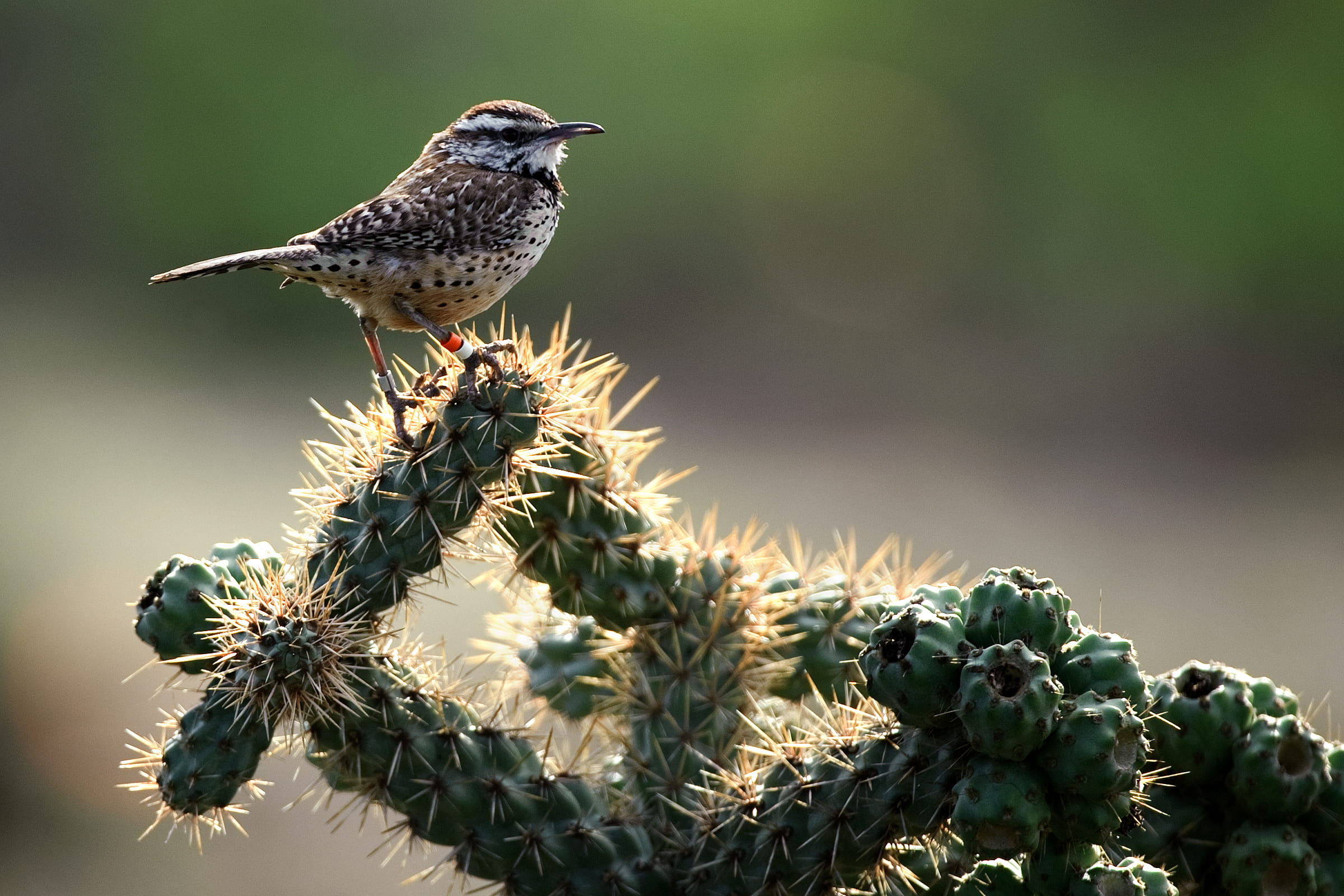Cactus restoration program is for the birds
UCI cactus restoration program aims to boost the population of a rare wren. Biologists are creating a welcoming habitat near campus that they hope will help the species thrive.

Kristine Preston steps softly onto UC Irvine’s
Ecological Preserve, 62 acres of cheerful wildflowers and sweet-smelling
sage scrub tucked above University Hills.
“We had a pair of
birds using this plant two days ago, which is just incredible,” she
whispers, pointing to a large prickly pear cactus. The 40-year-old plant
is one of a whole stand recently transplanted from a campus area slated
for development to a formerly weed-strewn four-acre patch of the
preserve.
Preston, science program director for the Nature Reserve of Orange County,
is glad to see the cacti seem to be doing well. But she’s more
interested in what could be hiding in the dense, bristling pads. Slowly,
she draws close, binoculars at the ready.
Disappointment. No noise, no flash of feathers.
Preston is on the
hunt for a cactus wren, a cheeky brown-and-white bird once common in
coastal Southern California. She’s thrilled that she spotted a male and
female in this little stretch of sage scrub earlier in the week. Born
last year in nearby territory, the male was caught and banded with
orange over white on his right leg.
He appears to have
taken up with a female born in 2009, banded in red and dubbed a
“floater” because she has no established territory. The male’s father
rules the adjacent land, so if this pair has already made itself at home
in the newly transplanted cactus, it will be a major success — with
babies possible by spring.
But even when
cactus wrens do hatch, they face tough odds finding their own home. Most
of the bird’s habitat has been chopped, lopped and crisscrossed by
highways, housing tracts and shopping malls. The Laguna Beach fire of
1993 and Santiago fire of 2007 each killed most of the birds on county
reserve lands and scorched 75 percent of their precious remaining
habitat.
“There’s been massive overdevelopment, and the fires really hurt,” says Peter Bowler,
a UCI senior lecturer in ecology & evolutionary biology who has
been studying or teaching at the campus since 1970. He gazes from the
hilltop preserve at a slope filled with houses. “This all used to be
wilderness.”
But biologists in suburbia learn to work with what they’ve got, as do the creatures they study. Bowler, Preston and Margot Griswold,
a veteran restoration ecologist hired by the Orange County
Transportation Corridor Agencies, are spearheading a collaborative
effort to bring the birds back.
The four-acre
cactus restoration program is part of a $600,000 project funded by the
California Department of Transportation and the Orange County
Transportation Authority in exchange for bulldozing sage scrub for roads
elsewhere. Another eight acres at the preserve will be stripped of
invasive plants with no natural predators that are crowding out
beautiful native grasses and wildflowers.
The aim is to
nurture a loose chain of cactus wren habitat patches stretching from
near the Fashion Island mall to above the Coyote Canyon Landfill. These
bits of habitat could serve as signposts to cactus wrens that there are
other homes available — which could prevent inbreeding and genetic loss.
The transplanted
mini cactus forest, on a knobby knoll and adjoining slopes above State
Route 73, is a key piece. Biologists hope the normally sedentary birds
will perch there, spy the distinctive outlines of existing cacti and
sage scrub on the other side of the freeway and fly over eight lanes of
traffic to reach it.
“The UCI preserve
has one of the largest wren populations in the area, and in addition to
providing new cacti for them to use here, cacti will be placed in
line-of-sight locations to link the preserve with other populations,”
Bowler says. “This is a very exciting project.”
On a sparkling
morning at the preserve, birdsong rises over the drone of traffic and
planes taking off from John Wayne Airport. Dozens of birds are happily
chirping, whirring and circling. A flock of tiny bushtits dances between
silvery green artemisia and blooming pink lemonade berry bushes.
Sparrows, towhees,
even Bewick’s wrens and federally threatened California gnatcatchers are
all visible. The cactus wrens, though, have vanished. A good-sized
Cooper’s hawk perches hungrily on a fence post, worrying Preston.
The cactus wren has
a long, hooked beak; a razor-top head; and a sleek, dark bar across its
cheeks and beady red eyes. It’s a medium-sized bird that takes shelter
from hawks, snakes and other predators in a cactus’s piercing needles.
But it doesn’t always get there in time.
Slowly, Preston
circles the preserve, narrating a virtual wren soap opera: A first
“wife” was booted out by a younger “wife” and flew across the toll road,
finding a new mate and home. There have been a lot of cactus wren
“divorces” lately, Preston says, and she’s not sure why.
The male bird she’s
looking for may have been driven out by its father, anxious to preserve
his own precious habitat. Preston has also forgotten her bird-call
tape, which she hoped to use to rustle up the wren. It’s been that kind
of morning. Still, it’s a beautiful day.
There’s a click-clicking in a low tangle of buckwheat and coastal cholla cacti. It is a cactus wren, annoyed by noisy intruders but not the one she’s seeking.
Finally, Preston
turns to head back to her car. Something catches her attention, way back
on the first cactus. It’s her bird, perched on the very top, preening
and cocking an eye at the blue sky.